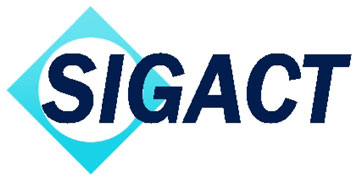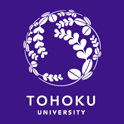Home
 Photo : Sunday,
Monday,
Tuesday,
Wednesday
Photo : Sunday,
Monday,
Tuesday,
Wednesday
The 30th Annual Symposium on Computational Geometry (SoCG 2014) will be held in Kyoto University Centennial Memorial Hall, Kyoto, Japan, as part of the Computational Geometry Week. We invite submissions of high-quality papers, videos, and multimedia presentations describing original research addressing computational problems in a geometric setting, in particular their algorithmic solutions, implementation issues, applications, and mathematical foundations. The topics of the Symposium reflect the rich diversity of research interests in computational geometry. They are intended to highlight both the depth and scope of computational geometry, and to invite fruitful interactions with other disciplines. Topics of interest include, but are not limited to:
- design, analysis, and implementation of geometric algorithms and data structures; lower bounds on the computational complexity of geometric problems;
- mathematical, numerical, and algebraic issues arising in the formulation, analysis, implementation, and experimental evaluation of geometric algorithms and heuristics; discrete and combinatorial geometry; computational topology;
- novel algorithmic applications of geometry in computer graphics, geometric modeling, computer-aided design and manufacturing, scientific computing, geographic information systems, database systems, robotics, computational biology, machine learning, sensor networks, medical imaging, combinatorial optimization, statistical analysis, discrete differential geometry, theoretical computer science, graph drawing, pure mathematics, and other fields.
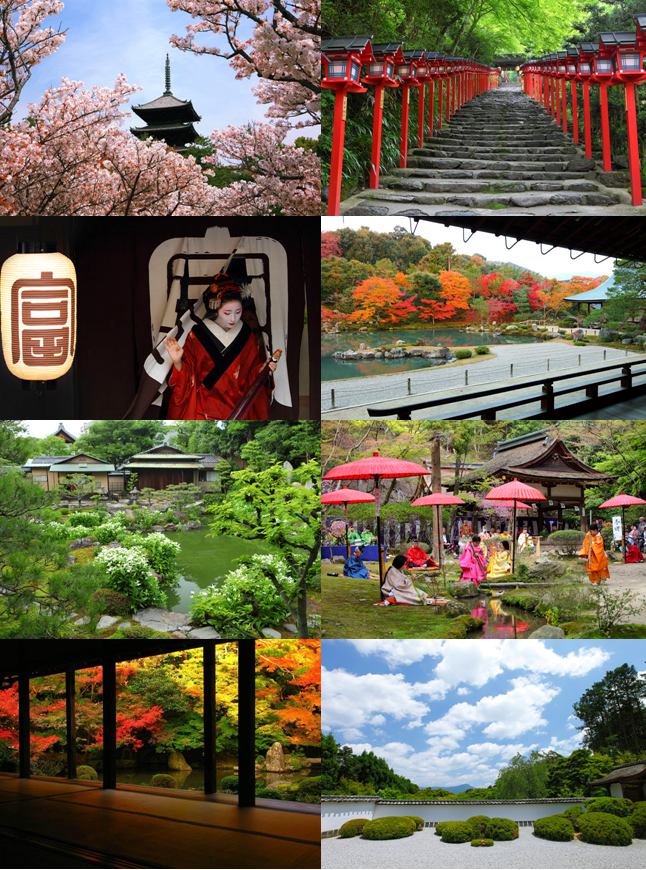
Venue
The conference will take place at Centennial Memorial Hall,
Clock Tower Centennial Hall,
Kyoto University, Kyoto, Japan.

Invited Speakers
Registration
Registration is now open for SoCG 2014 and Computational Geometry Week.
Regstration Closed
Registration fees are as follows:| Early Registration (March 1 - May 10) |
Late Registration (May 11 - June 7) |
On-site Registration | ||
| Full Registration | Regular | 35,000JPY | 45,000JPY | 45,000JPY |
| Student | 18,000JPY | 23,000JPY | 28,000JPY | |
| 1-day Workshop | - | - | 10,000JPY/day | |
Full Registration(SoCG2014 + Workshop)
Early registration deadline is May 10, 2014. Full Registration includes attendance of SoCG conference, all workshops, coffee breaks, banquet, and USB proceedings.Student registrants will be asked to show student ID at the registration desk.
1-day Workshop Registration
If you would like to attend only workshop, please register as 1-day Workshop. The payment will be made in cash(JPY) on-site at the registration desk.Extra Banquet Ticket
Please contact us (socg2014@dais.is.tohoku.ac.jp).Lunch
On your own.Program
CG Week 2014 Program (booklet)
Conference Booklet including local information
Conference venue (Clock Tower Centennial Hall) will be open at 9:00.
You can enter the building from 9:00.
Please patiently wait if you arrive early.
We are sorry for this inconvenience.
June 8(Sun), 2014
June 9(Mon), 2014
June 10(Tue), 2014
June 11(Wed), 2014
Workshops in CG Week 2014
Satellite Workshop
Important Dates
Call for Papers(pdf)The 30th Annual Symposium on Computational Geometry (SoCG) will be held in Kyoto, Japan, as part of Computational Geometry Week. We invite submissions of high-quality papers that describe original research on computational problems in a geometric setting, in particular their algorithmic solutions, implementation issues, applications, and mathematical foundations. Topics of interest include, but are not limited to:
Publication and AwardsFinal versions of accepted papers will be published by ACM in the symposium proceedings. Proceedings will be distributed to symposium participants and will also be available from ACM for purchase and through the ACM digital library. An author of each accepted paper will be expected to attend the Symposium and give a presentation (approximately 20 minutes) of the paper. Authors of a selection of papers from the conference will be invited to submit extended versions of their papers to a special issue of one or two journals. We plan to confer a Best Paper Award and a Best Student Presentation Award. The Student Presentation award will be based on the quality of the presentation of a paper by a student during the conference. The authors of the Best Paper Award will be invited to submit their work to the Journal of the ACM.Paper SubmissionAll submissions must be made electronically; see the EasyChair SoCG2014 web page (https://www.easychair.org/conferences/?conf=socg2014) for detailed submission instructions.Submission GuidelinesPapers should be submitted in the form of an extended abstract, which begins with the title and abstract page that contains the title of the paper, each author's name, affiliation, and e-mail address followed by a short abstract. Authors can add on this title page a special section containing any remarks for the program committee (journal submission, conflict of interest...). The main body of the extended abstract should begin with a precise statement of the problem considered, a succinct summary of the results obtained (emphasizing the significance, novelty, and potential impact of the research), and a clear comparison with related work. The remainder of the extended abstract should provide sufficient detail to allow the program committee to evaluate the validity, quality, and relevance of the contribution. Clarity of presentation is very important; the whole extended abstract should be written carefully, taking into consideration that it will be read and evaluated by both experts and non-experts, often under tight time constraints.Submissions should be typeset in single column format, using 11-point or larger font, with at least 1 inch/2.54 cm margins and single line spacing. Excluding the title page and bibliography, the extended abstract must not exceed 10 pages. Submissions deviating from these guidelines risk rejection without consideration of their merits. If possible, lines should be numbered (e.g. using lineno latex package). All necessary details to verify the results must be provided. If they cannot fit within the 10-page limit, a clearly marked appendix containing omitted details should be included. Appendices are not counted in the 10 page limit, so while they may serve as a reference, they will be read by the program committee members at their discretion. The paper excluding the appendix should clearly describe the results and the approach to achieve them, and give sufficient confidence for their validity. The appendix should then give all the necessary details to verify correctness. Anticipating the usual high overall quality of submissions, the program committee intends to interpret the scope of the conference broadly, and will seriously consider all papers that are of significant interest to our research community. Authors must submit the title and an abstract (at most 300 words) of their papers by November 22, 2013 (23:59, UTC-12). This pre-submission will be used to help make program committee reading assignments. Extended abstracts must be received by December 3, 2013 (23:59, UTC-12). There will be no extension of these deadlines; late submissions will not be considered. Authors will be notified of acceptance or rejection by February 14, 2014; reviews will be sent by February 21, 2014. The final proceedings papers must be formatted in accordance with ACM proceedings guidelines. They are due on March 24, 2014. LaTeX style files will be made available to authors of accepted papers. Results previously published in another conference proceedings cannot be submitted to SoCG. Simultaneous submissions of the results to another conference with published proceedings are not allowed. Exempted are workshop or conference handouts containing short abstracts not exceeding four pages in length. Results that have already been accepted (with or without revision) for publication by a journal, at the time of their submission to SoCG, will not be allowed. A paper submitted to a journal but not yet accepted to a journal can be submitted to SoCG. In such cases, the authors must mention it in page zero, the title and abstract page, and include the full journal version in an appendix that clearly identifies the status of the journal submission on November 22, 2013. For questions regarding SoCG submissions: 
SoCG 2014 Accepted Papers(pdf)Lower bounds on geometric Ramsey functions Curves in R^d intersecting every hyperplane at most d+1 times Finding the Largest Disk Containing a Query Point in Logarithmic Time with Linear Storage On the reconstruction of convex sets from random normal measurements Measuring Distance between Reeb Graphs Stochastic Convergence of Persistence Landscapes and Silhouettes The Morse theory of ?ech and Delaunay filtrations Gromov-Hausdorff Approximation of Filament Structure Using Reeb-type Graph On the Complexity of Randomly Weighted Voronoi Diagrams THE OPAQUE SQUARE Quasi-Polynomial Time Approximation Scheme for Sparse Subsets of Polygons Weight Balancing on Boundaries and Skeletons Embeddability in the 3-sphere is decidable Intersection of paraboloids and application to Minkowski-type problems Metric Embedding, Hyperbolic Space, and Social Networks Higher Dimensional Cheeger Inequalities Induced Matchings of Barcodes and the Algebraic Stability of Persistence Eliminating Tverberg Points, I. An Analogue of the Whitney Trick There are Plane Spanners of Maximum Degree 4 Counting and Enumerating Crossing-free Geometric Graphs Peeling potatoes near-optimally in near-linear time Optimal Geometric Flows via Dual Programs Distinct distances on algebraic curves in the plane Computing the Frechet distance with shortcuts is NP-hard Sub-linear Time Hybrid Approximations for Least Trimmed Squares Estimator and Related Problems Incidences between points and lines in $\reals^4$ On the Impossibility of Dimension Reduction for Doubling Subsets of $\ell_p$ Linear transformation distance for bichromatic matchings Separation by Convex Pseudo-Circles Delaunay triangulations with disconnected realization spaces The Discrete Fr\'echet Distance with Shortcuts via Approximate Distance Counting and Selection Merge Graphs of Join and Split Trees Outerstring graphs are chi-bounded The Persistent Homology of Distance Functions under Random Projection A near-optimal approximation algorithm for Asymmetric TSP on embedded graphs Near-Linear Algorithms for Geometric Hitting Sets and Set Covers Free Edge Lengths in Plane Graphs Continuously Flattening Polyhedra Using Straight Skeletons Improved bounds for the conflict-free chromatic art gallery problem Better $\varepsilon$-Dependencies for Offline Approximate Nearest Neighbor Search, Euclidean Minimum Spanning Trees, and $\varepsilon$-Kernels On Constant Factors in Comparison-Based Geometric Algorithms and Data Structures Light spanners for snowflake metrics Euclidean Steiner Shallow-Light Trees Sampling with Removal in LP-type Problems The limited blessing of low dimensionality: when $1-1/d$ is the best possible exponent for $d$-dimensional geometric problems On triple intersections of three families of unit circles Polynomials vanishing on grids: The Elekes-R\'onyai problem revisited Liftings and stresses for planar periodic frameworks Progressive Geometric Algorithms Two-Point L_1 Shortest Path Queries in the Plane Using Convex Relaxations for Efficiently and Privately Releasing Marginals Discrete systolic inequalities and decompositions of triangulated surfaces New and Improved Spanning Ratios for Yao Graphs Computing Topological Persistence for Simplicial Maps A Framework for Computing the Greedy Spanner Smallest enclosing ball for probabilistic data Efficient Random-Walk Methods for Approximating Polytope Volume A Census of Plane Graphs with Polyline Edges Better embeddings for planar Earth-Mover Distance over sparse sets Higher-Quality Tetrahedral Mesh Generation for Domains with Small Angles by Constrained Delaunay Refinement
Call for Videos and Multimedia Presentations (pdf)
part of 30th Annual Symposium on Computational Geometry (SoCG 2014) Call for Workshops (pdf)
Computational Geometry: Young Researchers Forum -- Call for Papers(pdf)
The 30th Symposium on Computational Geometry (SoCG) will take place June 8-11, 2014 in Kyoto, Japan. It brings together the global community of researchers who work on a large variety of aspects that combine geometry, algorithms and applications. To allow a broad audience to actively participate in the community's major scientific event, this year SoCG will again be accompanied by a series of satellite events, which together constitute "CG Week 2014". See http://www.dais.is.tohoku.ac.jp/~socg2014/. Student Travel Support
NSF Travel GrantLimited amount of travel support for students (mainly from US) is available.Detail
Contact Jeff Erickson (jeffe@illinois.edu)
Support for Asian StudentsLimited amount of travel support for students of Asian institutes/universities who are going to give talks at SOCG or Young Researcher Forum is available.Contact (socg2014@dais.is.tohoku.ac.jp) Travel and Accommodation Information
Access from Airport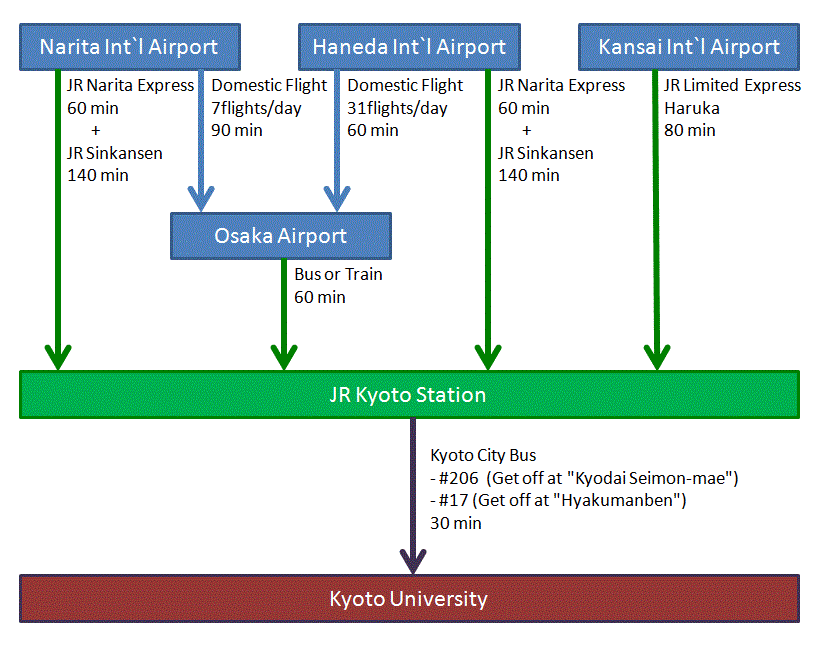
Travel to the conferece venue (from Kyoto Station)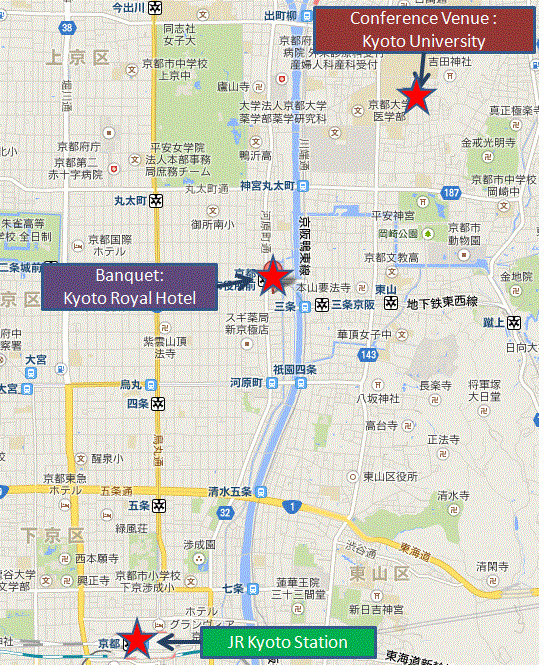
Take Kyoto City Bus Line #206 or #17 at Kyoto station bus terminal. It takes approx. 30 minutes. Flat rate fares (230 yen) will be charged. # 206: bound for Kitaoji Bus Terminal via Higashiyama St. Get off at "Kyodai Seimon-mae". # 17: bound for Ginkaku-ji via Kawaramachi St. Get off at "Hyakumanben". Adult:500 yen, Child:250 yen Can be used within the allocated zone of the city. Valid within the allocated zone. Unlimited use on the same day. When traveling outside of the allocated zone, it is necessary to pay the extra amount. Getting to Kyoto Universty Kyoto University Campus Map 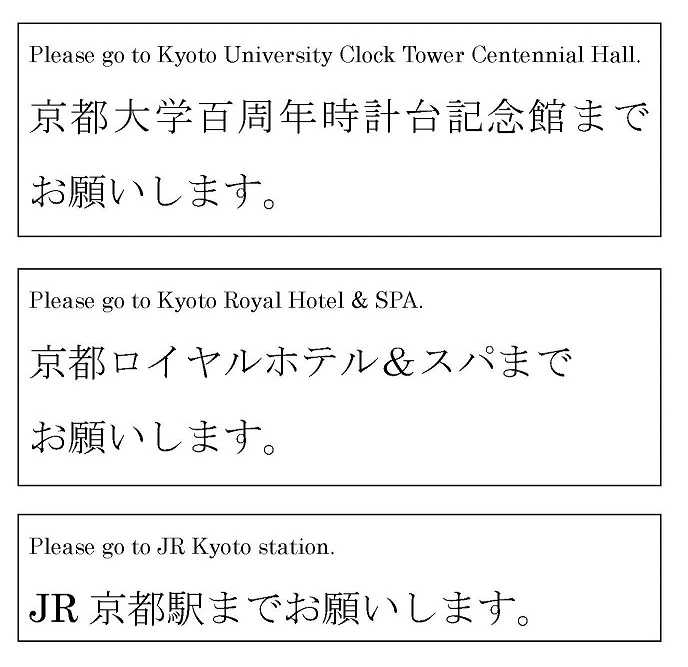
Accommodation
A variety of hotels are located around the Kyoto Station and Kawaramachi.
Accommodation Information (Recommendable Hotel list) Banquet place: Kyoto Royal Hotel & SPA Visa Application
If you need a visa to visit Japan, please take the following steps.
As soon as the documents are ready, we will send them to you. Committees
Program Committee
Local Arrangements Committee
SoCG 2014 and CG Sponsors
The conference is organized in cooperation with SIGACT and SIGGRAPH:We would like to thank supports:Contact
What's New
Home is updated. Program, Travel are updated. Workshops in CG Week 2014 is updated. Workshops in CG Week 2014 is updated. Workshops in CG Week 2014 is updated. Tentative Schedule is updated. Accommodation Information is updated. Tentative Schedule is updated. Workshops in CG Week 2014 is updated. Student Travel Support is updated. SoCG2014 Program is announced. Submission deadline for the Young Researchers Forum has been extended. Tentative Schedule and Workshops in CG Week 2014 are updated. Registration is open. Young Researchers Forum submission is open. Travel and Accommodation Information , Registration , Student Travel Support and VISA Application are updated. SoCG Accepted papers is updated. Call for Young Researchers Forum is updated. Call for Workshops is updated. Call for Videos and Multimedia Presentations is updated. Call for SoCG2014 Papers is updated.
| |||||||||||||||||||||||||||||||||||||||||||||||||||||||||||||||||||||||||||||||||||||||||||||||||||||||||||||||||||||||||||||||||||||||||||||||||||||||||||||||




